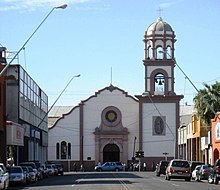History[edit]
Early history[edit]
The Spaniards arrived to the area after crossing the Sonoran Desert's "Camino del Diablo" or Devil's Road. This led to the evangelization of the area by Catholic missionaries and also to the reduction of native populations in the region. Nowadays, indigenous Cocopah people still inhabit a small government-protected corner of the Colorado River delta near the junction of theHardy and the Colorado. The Cocopah mostly work on agricultural ejidos or fishing.[1]
The early European presence in this area was limited to Anza's and subsequent Spanish expeditions across the Colorado Desert and subsequent travelers on the Sonora Road opened by them. Also the presence of the Jesuits who attempted to establish a mission in what is now Fort Yuma. They left after a revolt by the Yuma in 1781. After this, the Spanish had little to do with the northeastern corner of the Baja California Peninsula, perceiving it as an untamable, flood-prone desert delta.[1] Later in the 1820s, the Mexican authorities reopened the Sonoran Road and restored peaceful relations with the Yuma People.[2]
The Sonoran Road provided a route for American fur trappers, and later American troops of Kearny and Cooke passing through the area during the Mexican–American War. The annexation of most of Alta California soon was followed by the California Gold Rush that saw a flood of gold seekers from Mexico on the Sonora Road, especially from Sonora, and from the United States via the Southern Emigrant Trail. Herds of cattle and sheep were driven into California across this desert trail also.
This route became a U. S. Mail and stagecoach route in 1857 when the San Antonio-San Diego Mail Line and in 1858 Butterfield Overland Mail route passed along the Alamo and New Rivers and established stations there including its New River Station in the vicinity of a Laguna along the New River in what is now Colonia Hidalgo, Mexicali in 1858. This mail route remained in use until 1877 when the Southern Pacific Railroad came to Yuma making it obsolete.
Late 19th century[edit]
In the mid-19th century, a geologist working for the Southern Pacific Railroad came to the delta area, discovering what the native Yumans had known for centuries: that the thick river sediment deposits made the area prime farming land. These sediments extended far to the west of the river itself, accumulating in a shallow basin below the Sierra de Cucapá.[1] However, from this time period until the 1880s, the area was almost completely unpopulated, mostly due to its harsh climate. In 1888, the federal government granted a large part of northern Baja state, including Mexicali, to Guillermo Andrade, with the purpose of colonizing the area on the recently created border with the United States. However, around 1900, the only area with any real population, aside from the Cocopah, were concentrated in Los Algodones, to the east of Mexicali.[3]
20th century[edit]
In 1900, the U.S.-based California Development Company received permission from the government of Díaz to cut a canal through the delta's Arroyo Alamo, to link the dry basin with theColorado River. To attract farmers to the area, the developers named it the "Imperial Valley". In 1903, the first 500 farmers arrived; by late 1904, 405 km² (100,000 acres) of valley were irrigated, with 10,000 people settled on the land harvesting cotton, fruits, and vegetables. The concentration of small housing units that straddled the border was called Calexico on the U.S. side and Mexicali on the Mexican side.[1] Led by Los Angeles Times publisher Harry Chandler, one company controlled 800,000 hectares of land in northern Baja California by 1905, and began to build the irrigation system for the Valley. However, instead of using Mexican labor to dig the ditches, Chandler brought in thousands of Chinese laborers.[1] Mexicali became culturally more Chinese than Mexican.
The Mexican side was named Mexicali (a portmanteau composed of "Mexico" and "California") by Coronel Agustín Sanguinéz. Initially the area belonged to the municipality of Ensenada.[3]The town of Mexicali was officially created on 14 March 1903 when Manuel Vizcarra was named as the town's first authority and Assistant Judge (juez auxiliar).[1] On January 29, 1911, Mexicali was briefly "liberated" by the Liberal Party of Mexico during the Mexican Revolution. Mayor Baltazar Aviléz declared the municipality of Mexicali on November 4, 1914 and called for elections to creation of the first ayuntamiento or Municipality, which was then headed by Francisco L. Montejano.[3]
In the 20th century, the Colorado Riverland Company, a U.S. based company, was dedicated to renting Mexican land to farmers; however, these farmers were almost always foreigners, such as Chinese, East Indians and Japanese. The Mexicans were employed only as seasonal laborers. This situation led to the agrarian conflict known as the "Asalto a las Tierras" (Assault on the Lands) in 1937.[3] in which Mexican land was taken by Mexicans.
Agricultural production continued to increase during the 20th century. Cotton became the most important crop and it help develop the textile industry. In the early 1950s, the Mexicali Valley became the biggest cotton-producing zone in the country and in the 1960s, production reached more than half a million parcels a year. Currently, the Valley still is one of Mexico's most productive agricultural regions, mostly producing wheat, cotton and vegetables. The city of Mexicali is one of Mexico's most important exporter of asparagus, broccoli, carrots, green onions, lettuce, peas, peppers, radishes and tomatoes to the world.[1]
The government of the municipality was reorganized when the Baja California territory became the 29th state in 1953.[3]


No comments:
Post a Comment